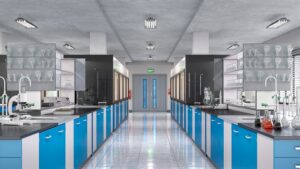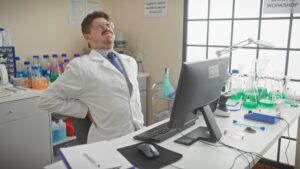
When choosing modern equipment for your company, a common concern is the safety of your users and the quality of the experiments. When purchasing your machinery, it is important to confirm that your manufacturer meets and exceeds these various standards to ensure the safety of your team and the success of your experiments.
Below we’ve broken down the general safety standards and seals of approval you should look out for when sourcing machinery for your laboratory, with special focus on fume hood manufacturing.
UL 1805 Listed
UL is one of the oldest testing agencies in the country, and provides safety verification of various modern machinery and other environmental claims. There is no general UL approval, rather the approvals are broken up into different categories.
For your fume hood, UL 1805 Listed is most ideal. This verifies that a manufacturer can make products that fulfill UL requirements. This means that the manufacturer is able to test the safety of the product in their own factory.
The general scope of this listing, as taken directly from the Standards Catalog, is for these requirements, applied to laboratory hoods and cabinets to provide an enclosed countertop work area with exhaust for containment and removal of vapors, mists, gases and particulate matter from the work area. To read more on the scope you can find the official listing page here.
ASHRAE 110
ASHRAE is the American Society of Heating Refrigeration and Air-conditioning Engineer. They set the general standards for testing mechanical systems. ASHRAE 110 is a specific test for fume hoods that measure the containment of chemicals within the hood. More specifically, the test measures the inflow velocity profiling and airflow of smoke. These provided an analysis of air capture within the unit, demonstrating its effectiveness to operate safely.
Standard practice in the industry should be to have ASHRAE tested as manufactured. This simply means the fume hoods are tested in the factory before delivery to client. After the hoods are installed, the customer can choose to have an ASHRAE 110 Test ‘As Installed’ by a third-party certification company, such as TSS or ECT. You can contact Genie for a list of names and contacts in your area.
SEFA
SEFA, the Scientific Equipment and Furniture Association, is combined of laboratory owners, architects, contractors and other leading members in the industry. Members work together to enhance company performance and “the improvement of the quality and timely completion of laboratory facilities.”
Your fume hood should be built to meet and exceed the SEFA 1 Recommended Practice for Laboratory Fume Hoods.
Cal/OSHA, also known as the Division of Occupational Safety and Health (DOSH) works to protect the health and safety of individuals through:
1. Setting and enforcing standards
2. Providing outreach, education and assistance
3. Issuing permits, licenses, certifications, registrations and approvals.
It is important to make sure your fume hood meets OSHA & Cal/OSHA safety requirements, or other requirements for your state. This specifically calls for airflow calculations to meet 100 Feet Per Minute face velocity.
Additional Safety Features
On top of the necessary safety standards and requirements for your fume hood, there is safety in added features. One of the most vital safety devices in a working lab and fume hood is the front sash. The front sash is the barrier between the users and dangerous fumes, and acts as a physical shield and protects the users breathing zone. We recommend using laminated safety glass on your front sash due to its explosion proof material.
The back baffle system is another ideal safety feature. The purpose of the back baffle system is to direct air away from user breathing zones and create calm currents in the hood. Without a back baffle system turbulent eddies will exist that can cause fumes to escape.
All fume hoods should also have an airflow monitor that continuously indicates whether air is flowing into the hood during operation. Ideally, this monitor has an audible and visual indicator to alert the user when the airflow dips below a certain set point. These airflow alarms are required by Cal/OSHA regulations.
Important: Fume hoods only function safely when connected to a properly engineered and balanced HVAC system and building utility services. Failure to verify compatibility with your building can result in an unsafe system. Consult the proper trade professionals and a Genie fume hood expert with questions.



